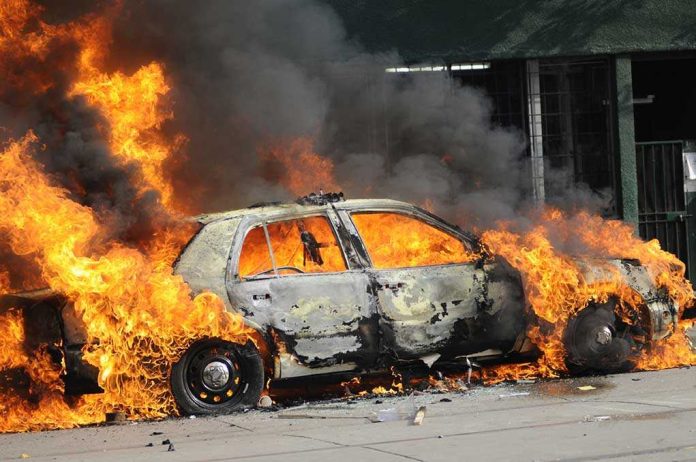
When a car bomb erupts outside the home of Italy’s most fearless investigative journalist, the real target isn’t just one man—it’s the very backbone of press freedom in Europe.
Story Snapshot
- Sigfrido Ranucci, host of Rai 3’s “Report,” survives a car bomb attack near Rome, intensifying concerns for journalist safety in Italy.
- The attack follows years of escalating threats against Ranucci, famed for exposing organized crime and corruption.
- The bombing’s timing—on the anniversary of Daphne Caruana Galizia’s murder—sends a chilling message to Europe’s press corps.
- Outcry from Italian officials and global media freedom advocates puts pressure on authorities to act decisively.
Assault on Press Freedom in the Heart of Italy
Barely past ten o’clock on October 16, 2025, a powerful explosion shattered the quiet in Pomezia, a suburb outside Rome. The intended victim: Sigfrido Ranucci, a household name for viewers of “Report,” Italy’s tenacious investigative news show. Twenty minutes after his daughter parks the family car, a hidden bomb detonates nearby—damaging two vehicles and a home but miraculously sparing lives. The scene is chaos, but the message is surgical: no one who exposes the mafia or corruption is untouchable.
For years, Ranucci has occupied a perilous intersection between truth-telling and entrenched criminal power. Since at least 2010, threats have shadowed his footsteps—bullets left outside his door, ominous surveillance, and relentless attempts to discredit his reporting. This latest attack is no isolated incident. It is the crescendo of a campaign to silence a voice that refuses to yield, and it lands with a resonance that stretches well beyond Italy’s borders.
A Timeline of Fear and Defiance
Ranucci’s journey from reporter to target is mapped by a series of warnings that grew ever more brazen. A decade ago, police assigned him protection after he exposed mafia rackets. In 2024, bullets appeared outside his home—a mafia calling card as old as their code of silence. By 2025, the threats were not only persistent but public, with Ranucci reporting increased surveillance and attempts to stifle his work, even from within his own network, RAI. The tension escalated further when episodes of “Report” were cut and disciplinary hearings convened, raising uncomfortable questions about the depth of institutional support for embattled journalists.
🚨 A bomb destroys journalist Sigfrido Ranucci’s car near Rome — his daughter escapes by minutes. #Italy #PressFreedom pic.twitter.com/VbsECHiQTv
— Nihal Kumar (@NihalJrn) October 17, 2025
Yet the timing of the bombing was especially calculated. October 16 marks the anniversary of Maltese journalist Daphne Caruana Galizia’s assassination, itself a watershed moment for European journalism. The echo is unmistakable—a reminder that the mafia’s reach is not constrained by borders, and that journalists who dig too deep may pay the ultimate price. The symbolism isn’t lost on the Italian public or the global media community, both of whom responded with outrage and calls for action.
The Immediate Response: Security, Condemnation, and Political Fallout
Within hours of the explosion, Italy’s Anti-Mafia Investigation Division launched a formal probe, and the Interior Minister ordered maximum protection for Ranucci, including an armored car and armed escort. Prime Minister Giorgia Meloni denounced the attack as an assault on democracy itself, declaring that press freedom is “non-negotiable.” Media freedom organizations joined the chorus, warning that the attack represents a grave escalation in a country already grappling with rising hostility toward journalists.
Opposition leaders demanded urgent parliamentary hearings. The public broadcaster, RAI, found itself under a harsh spotlight, its management’s strained relationship with Ranucci now a matter of national debate. International watchdogs, including the International Federation of Journalists, called for sweeping reforms and a systemic overhaul of journalist protections. The message was clear: failure to act decisively could trigger a chilling effect that stifles investigative reporting far beyond Italy.
Long-Term Consequences and the Shadow of Organized Crime
The immediate aftermath is defined by heightened security and a surge of solidarity. But the underlying risks have only intensified. Ranucci and his family live under constant guard—a stark reminder that no amount of courage can entirely shield journalists from mafia retribution. The Italian media landscape, already battered by political and criminal pressures, now faces a moment of reckoning: Will the country reinforce its commitment to press freedom, or will fear and intimidation become the new normal?
For the broader public, the stakes are profound. When journalists are silenced or cowed, democratic accountability suffers, corruption thrives, and the invisible hand of organized crime tightens its grip. The explosion in Pomezia is not merely an attack on one man or one show; it is a warning shot aimed at every reporter with the temerity to question power. The fight for press freedom in Italy—and across Europe—enters a new, more dangerous phase.



